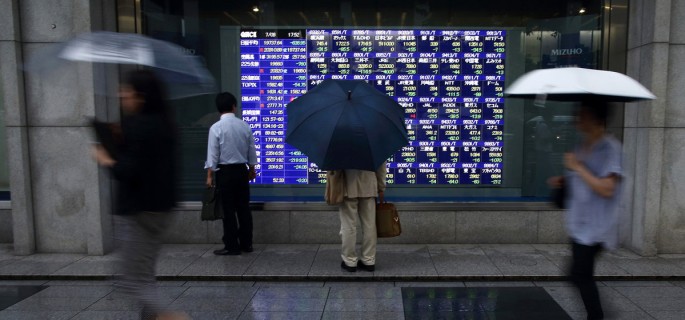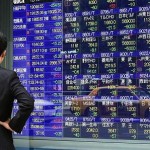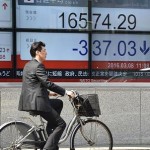Asia trades mixed; Chinese shares under pressure

Asian markets ended mostly higher on Monday, as traders shrugged off data released over the weekend that revived concerns over the Chinese economy.
Japan’s Nikkei 225 pared some of its over 1 percent gains from early morning to close up 54.19 points, or 0.33 percent, at 16,466.40, while across the Korean Strait, the Kospi ended near flat at 1,967.91. In Hong Kong, the Hang Seng index was up 1.25 percent.
Chinese mainland markets reversed their morning losses, with theShanghai composite up 0.24 percent and the Shenzhen compositehigher by 0.83 percent.
Australia’s ASX 200 finished up 29.41 points, or 0.55 percent, at 5,358.40, with a 0.59 percent gain in the financials sub-index which accounts for nearly half of the broader index.
Some of the mining stocks came under pressure, with shares ofSandfire Resources closing down 0.36 percent and South32 off by 1.48 percent. Major miners were positive, with Fortescue up 1.04 percent and Rio Tinto higher by 1.55 percent.
Angus Nicholson, a market analyst at spreadbetter IG, said relative strength in the dollar, following positive U.S. April retail sales numbersreleased on Friday, will likely increase challenges for the materials and energy space.
The dollar gained slightly against a basket of currencies, with the dollar index trading at 94.617 Monday afternoon in Asia, compared to the 93 levels it touched on Friday Asia time.
“The strongest increase in retail sales in more than a year drove the U.S. dollar sharply higher against all of the major currencies, but the gains did not last,” said Kathy Lien, managing director of foreign exchange strategy at BK Asset Management. She added that investors quickly “realized that one good release won’t change anyone’s mind about leaving interest rates unchanged in June.”
Some analysts said despite the strong data, performance in the equity market will also drive the U.S. Federal Reserve’s decision on whether to hike interest rates in June or stand pat.
“A weak performance by U.S. equities saw the probability of the Fed Funds rate being 25-points higher by December fall to 60 percent from 64 percent on Thursday,” said Rodrigo Catril, a currency strategist at the National Australia Bank. “The Fed’s reaction function is still more equity dependent than data dependent in the market’s mind, or so it would seem.”
Major U.S. indexes closed lower Friday, with the Dow Jones industrial average down 1.05 percent, the S&P 500 off 0.85 percent and theNasdaq composite lower by 0.41 percent.
Data released by China’s National Bureau of Statistics showedinvestment, factory output and retail sales all grew more slowly than expected in April, with factory output cooling to 6 percent growth in April compared to market expectation for a 6.5 percent on-year rise, Reuters reported.
Nicholson said the slowdown “provides further evidence that [Beijing’s] aggressive first quarter stimulus appears to be leveling off into the second quarter.”
On Monday morning before market open, Bank of Japan (BOJ) data showed Japan’s producer price index for April fell 4.2 percent on-year, compared to a Reuters poll that expected a 3.7 percent on-year decline.
The yen traded at 108.74 against the dollar, compared to its last close at 108.60 and a Monday session high of 108.97. The marginal weakness, however, was not enough to give exporters a boost. Most major Japanese exporters closed mixed, with shares of Nissan up 0.53 percent, while Sony shares dropped 1.28 percent.
Usually a weaker yen is a positive for export stocks as it boosts their overseas profits when converted into the local currency.
Yen traders will also be watching for Japan’s first quarter gross domestic product numbers due this week. A Reuters’ poll showed that market watchers expect Japan to register an annualized growth rate of 0.2 percent for the January through March period.
“Growth is expected to turn positive after a negative quarter and given the market’s focus on the timing of BOJ easing, stronger or weaker growth could have an unusually significant impact on the yen,” said Lien.
Elsewhere, the Australian dollar advanced slightly against the greenback, trading at $0.7277 after last closing at $0.7263. But the Aussie remains well off from the $0.78 level it briefly touched in April.
Oil prices also advanced on Monday in Asia, with global benchmark Brent up 1.38 percent to $48.49 a barrel, while U.S. crude futures added 1.34 percent to $46.83.
Energy plays, however, traded mostly lower, with Santos down 0.72 percent, Woodside Petroleum down 0.7 percent and Chinese mainland shares of Sinopec down 0.81 percent. Japan’s Inpex bucked trends to trade up 0.17 percent.
Source: CNBC




























